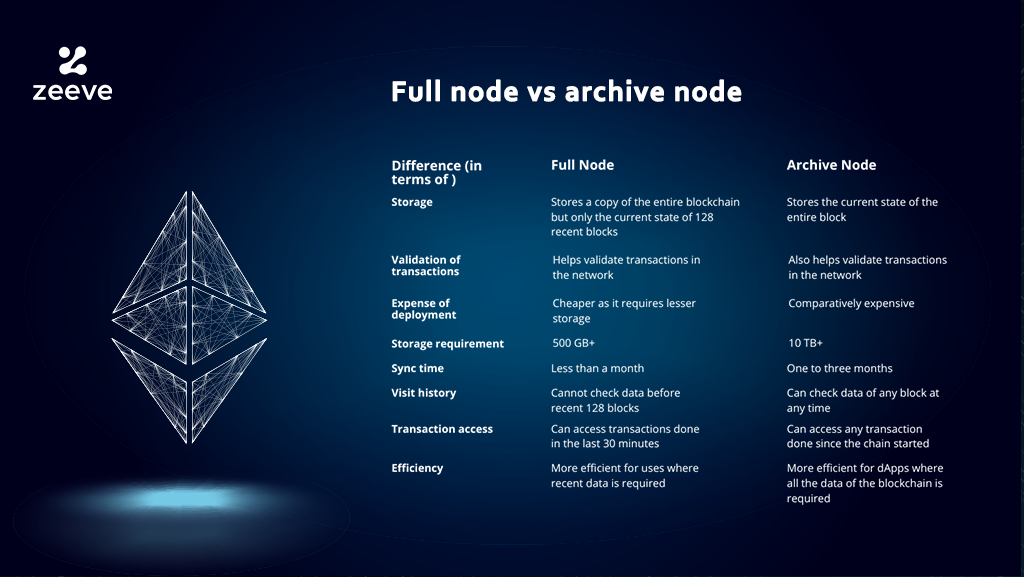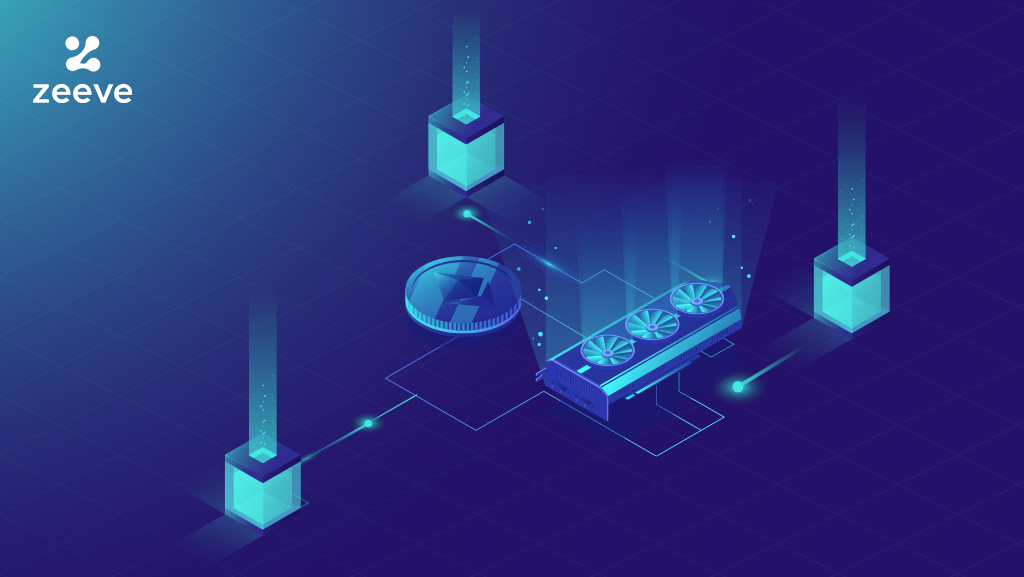Ethereum is a blockchain-based decentralized platform with smart contract capabilities. As of the platform, ether is the native cryptocurrency. Being the second biggest blockchain network in the blockchain space, Ethereum has a lot of technicalities to understand as well. One of which is the nodes.
Networks based on the Ethereum Virtual Machine (EVM) typically can run two types of nodes: a full node and an archive node. Let us take a deep dive into what exactly the nodes are and how they can help the Ethereum network in gaining scalability. In this blog, we will understand more about nodes and their types. We are going to dive into some details on the difference between a full node and an archive node for networks such as Ethereum Virtual Machine (EVM) based ones. We will explore what they do differently from each other in terms of how data is stored onto their respective nodes within these blockchains which can then be used during any given time period if something happens where everyone needs information about previous transactions across all blocks ever created.
Understanding Nodes in an Ethereum
Nodes are the backbone of blockchain technology. They keep up-to-date information on what’s happening within a network, which allows them to make sure no one transaction goes unnoticed or unanswered by others in line behind it as they verify each new piece for accuracy before broadcasting those pieces out into this interconnected web known simply as “the ledger.” As the number of nodes on our network increases, it becomes more difficult for hackers to take down.
The reason we require nodes is that suppose you need data related to a year back now for that you need to check the full transaction of the past one year. However, if we use archive nodes we will get the information much more quickly. This will not consume a lot of time and resources, unlike the full node.
How do nodes work?
In simple language, a node is a vertex in a tree diagram. Well, they are not exactly vertices in the Ethereum network, it’s a lot more than just that. In the Ethereum network, nodes are the vertices (but can be more accurately referred to as junction points) in the network. A node can be anything, literally from a mere mobile phone to a system as big as a supercomputer, from simple software to a piece of complex hardware, in the network.
Take this as an analogy, there is an organization communicating and coordinating with each other, then that organization can be considered a part of the network and everyone working in it as a node. Similarly, every device on that Ethereum network, which has a copy of the blockchain, can be considered a node. The more the number of nodes, the more the network will become faster and more secure.
Ethereum nodes help to validate transactions, protect the data from being encrypted, and improve the scalability of the network. With all these frameworks such as Chainstack and Embark available today, it has been a lot easier for everyone to deploy a node on the Ethereum mainnet.
Types of the nodes
Currently, the Ethereum network has somewhere around 17,000 active nodes working together for its sustainability. These 20,000 nodes include 3 varieties: Full nodes, Light nodes, and Archive nodes. Let’s take a dive into all these 3 types of nodes:
Full Node
Full nodes are necessary for running an efficient blockchain, but they come at the cost of limited request sizes. Full EVM node keeps track of both read-only and transactional data on behalf of your application’s needs; pruning older blocks saves disk space while reducing sync times when compared with light clients or synchronizing directly from peers. A full node is a node on the network that stores a copy of the whole blockchain in its most recent state. By most recent state, it means it stores the state of 128 recent blocks (or only 64 if you’re using fast/snap sync) and about one week of trace data updated as soon as the new block comes in. It helps in the verification of transactions in the network and protects its immutability.
You might want a fast CPU with four cores 16 GB of RAM, a fast SSD drive with a minimum of one TB of space, 25 MBit s bandwidth when running a full node.
Archive Node
An archive node is essentially a full node but more. Archive nodes provide an extra layer of storage and backup for your data. By storing older versions of your data, you can ensure that you always have a copy of it. This is especially helpful if something goes wrong and you need to restore your data. Archive nodes are also useful if you want to keep track of changes over time. This way, you can see how your data has changed over time, and make sure that any changes are accurate. Unlike a full node, an archive node stores everything kept in the full node and builds an archive of historical states since the genesis block. To access the data before 128 recent blocks, you need to request a full node to work in archive mode to get the data.
To start a new archive node, the system needs to synchronize all that data before it can start running on the network. This leads to high starting and maintenance costs, given that at this point it would take months to complete the syncing process, and constant maintenance is necessary to keep up with the growing disk size requirements.
A 4-core CPU with sufficient RAM is recommended to run a full archive node. A high performance SSD with a minimum of 12 TB of storage space is required. At least 25 MBit per second of bandwidth must be provided.
Light Node
Light nodes, as the name suggests, are lighter in data, that is, they don’t store the entirety of the blockchain but some summary (or the block header) of the block. Light nodes allow devices with less computational power to also participate in the Ethereum network. Light nodes have a lot to offer businesses and organizations.
A light node is essentially a mini server that provides some level of connectivity for devices that need it but don’t have the resources or bandwidth to connect directly to the network. This can include things like smart home devices, wearables, vehicles, and more. They’re often small enough to be embedded into other devices or used as part of a larger infrastructure solution, making them an ideal choice for businesses that want to save on costs while still having access to the latest innovations.
What are the differences between a full node and an archive node?
A full node has certain advantages over an archive node. An archive node only stores current state data, but a full node can keep track of all of the chain’s previous states.
Simply put, archive nodes contain all of the historical information since block one, whereas full nodes only contain the most valuable, current data required for validating new transactions while unnecessary blockchain data is “pruned.”
The above table gives a detailed explanation of full nodes and archive nodes. Although, in theory, you can use a full node to recalculate all the previous states of the blockchain, it would take an exceptionally long time and would be very resource-intensive, and your node might run out of memory and stop. Hence it is not very feasible. So, it is better to use a node that fits your requirements more.

Nodes after the merge!
The merge is the most anticipated event ever in the history of the Ethereum network. Ever since 2015, when Ethereum was invented, its developers were working on a more energy-efficient alternative for Ethereum. But it was not before December 2020, that they started to work on a side chain, Beacon chain, which has since existed as a separate blockchain to Mainnet, running in parallel.
It works on the Proof-of-Stake of consensus protocol rather than the energy-consuming Proof of our Work protocol, and the Ethereum network has been working on it. This beacon chain has continued to add empty blocks ever since and is expected to merge with the mainnet in August 2022.
After The Merge, the Beacon Chain will become the consensus engine for all network data. This will also include execution layer transactions and account balances. The merge will change a lot of things in the Ethereum network.
Currently, the Ethereum mainnet has about 20,000 nodes and the Beacon chain has about 5000 active nodes. After the merge, the number of nodes will suddenly increase, making it more secure. Changes we will see for nodes are as below:
- Full Node: Full nodes will be considered as validating nodes. Like before, they will still store a copy of the blockchain but will change the way they used to validate the blocks. Before the merge, validating a block was nothing but solving a large mathematical problem but it will be done through staking after the merge.
- Archive Node: Archive Nodes will continue to work in the same manner to maintain the data of the blockchain.
- Light Node: They are more like access-only nodes, that is, they will be able to access the data of the Ethereum blockchain but staking won’t be possible on Light Nodes. To have one of these nodes, it is enough to install an ETH 2.0 node and connect it to the Internet.
How to Choose the Right Type of Node
Choosing the proper type of Ethereum node to deploy depends upon your use case and resources because node setup and functionality differ significantly. You can use Ethereum in a private, self-sufficient, and trustless manner by running your own node . You don’t have to trust the network because your data may be verified by your own node client.
A full node has the advantage of being able to communicate directly with any smart contract on the public blockchain. Smart contracts can also be deployed now into the public blockchain by full nodes.
Full nodes may tax the hardware and bandwidth resources of your machine. Unlimited data usage, storage, and contract capabilities are not free, though.
Archive nodes store all of the information that a full node does and creates a history of blockchain states. Even after a client has completed synchronization, archive nodes will save previous data.
If your program needs historical blockchain data, then you’ll need to run a blockchain archive node, or pick a cloud provider that provides blockchain archive data access. Light nodes are similar to full nodes, but they cannot currently process large amounts of data. At one point, the header chain node saved header chain data, but only requested documents when requested.
Final Thoughts
Here we got an idea of what exactly nodes are, what their types are and the difference mainly between Full Node and Archive node and how they work, and also what happens to nodes after merge.
Having an understanding of how Ethereum nodes work, you can easily choose the best node as per your requirements suitable for the job. Developers need to deploy their own nodes for their dApps. So, an adequate knowledge of nodes is provided above to get you started on your journey to build in the Ethereum network.
If you need to simply access a summary of the data of the blocks, you know, just use a light node. If you wish to have access to recent detailed data of the blockchain, go on for the use of a full node. If you need access to all the data ever done in the history of the Ethereum network, use an archive node, it’s as simple as that.
Partner With Zeeve as Node Infrastructure Management Platform
Zeeve is a web3 node infrastructure provider and blockchain infrastructure management platform that uses an advanced node hosting system to support web3 developers with scalability, stability, and real-time data accuracy.
Zeeve supports the deployment and monitoring of all types of Ethereum networks. however they also offer support for other blockchains which includes Binance Smart Chain (BSC), Axia, Polygon, Avalanche, Tron, Fantom, Polkadot and more. We also provide detailed cloud monitoring alongside Ethereum parameters, which helps maintain your node’s uptime.
We are a leading blockchain infrastructure company supporting businesses and blockchain-based start-ups to create, deploy, and manage decentralized applications and blockchain networks.
Zeeve is a low-code automation platform that supports the backends of several blockchain protocols and provides comprehensive analytics. It not only deploys and builds the blockchain networks but also supervises their nodes.
Get in touch with our team to learn about our blockchain sharing, managing, and deploying infrastructure platform.





